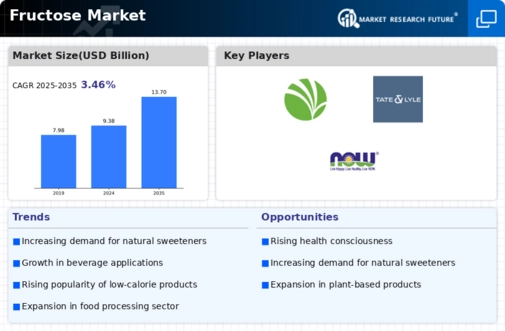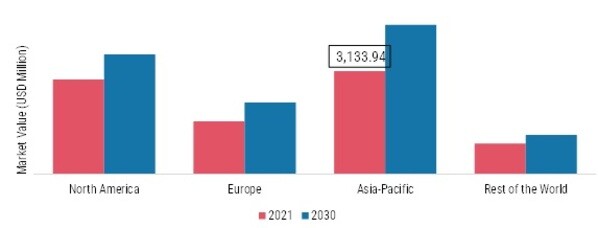-
CONTENTS
-
EXECUTIVE SUMMARY 21
-
MARKET ATTRACTIVE ANALYSIS, BY REGION 23
-
GLOBAL FRUCTOSE MARKET, BY SOURCE 24
-
GLOBAL FRUCTOSE MARKET, BY
-
PRODUCT 25
-
GLOBAL FRUCTOSE MARKET, BY FORM 26
-
GLOBAL FRUCTOSE MARKET, BY APPLICATION 27
-
GLOBAL FRUCTOSE MARKET,
-
BY DISTRIBUTION CHANNEL 28
-
GLOBAL FRUCTOSE MARKET, BY REGION 29
-
MARKET INTRODUCTION 30
-
DEFINITION 30
-
SCOPE OF THE STUDY 30
-
RESEARCH OBJECTIVE 30
-
MARKET STRUCTURE 31
-
RESEARCH METHODOLOGY 32
-
RESEARCH PROCESS 32
-
PRIMARY RESEARCH 33
-
SECONDARY RESEARCH 34
-
MARKET SIZE ESTIMATION 35
-
FORECAST MODEL 36
-
LIST OF ASSUMPTIONS & LIMITATIONS 37
-
MARKET DYNAMICS 38
-
INTRODUCTION 38
-
DRIVERS 39
- INCREASED AWARENESS
-
OF CONSUMERS TOWARD SUGAR SUBSTITUTE 39
-
WIDER APPLICATION AREAS TO ENHANCE THE MARKET GROWTH
-
RESTRAINTS
- EXCESS
-
CONSUMPTION OF FRUCTOSE MAY LEAD TO HEALTH ISSUES 41
-
OPPORTUNITIES 42
- GROWING TECHNICAL INNOVATION IN THE FOOD PROCESSING
-
SECTOR 42
-
CHALLENGES 43
-
HIGH COST ASSOCIATED WITH THE MANUFACTURING OF FRUCTOSE 43
-
MARKET FACTOR ANALYSIS 44
-
VALUE CHAIN ANALYSIS 44
- RAW MATERIAL 44
- PROCESSING 45
- ENZYMATIC REACTION 45
- BLENDING 45
- PACKAGING 45
-
SUPPLY CHAIN ANALYSIS 46
-
PORTER''S FIVE FORCES MODEL 47
- THREAT OF NEW ENTRANTS
- BARGAINING
-
POWER OF SUPPLIERS 48
-
BARGAINING POWER OF BUYERS 48
-
THREAT OF SUBSTITUTES 48
- INTENSITY OF RIVALRY 48
-
IMPACT OF THE COVID-19 OUTBREAK ON THE GLOBAL
-
FRUCTOSE MARKET 49
-
OVERVIEW 49
-
IMPACT ON PRODUCTION 49
-
IMPACT ON SUPPLY CHAIN 49
- IMPACT ON PRICING 49
-
CATEGORY INSIGHTS 50
-
SUPPLY-DEMAND OUTLOOK 50
-
MARKET OVERVIEW 50
-
SUPPLY-DEMAND ANALYSIS 51
- DEMAND ANALYSIS 51
- SUPPLY ANALYSIS 52
- CATEGORY TRENDS 52
-
INDUSTRIES TO ENHANCE THE MARKET GROWTH 52
-
PHARMACEUTICAL INDUSTRY: 52
- COSMETICS: 53
- FOOD AND BEVERAGE:
- MRFR
-
POINT-OF-VIEW 53
-
COST STRUCTURE ANALYSIS 53
-
COST STRUCTURE BREAKDOWN 53
- COST COMPONENT & IMPACT ON OVERALL PRICING
-
FACTORS AFFECTING THE COST OF RAW MATERIAL 54
-
RUSSIA- UKRAINE WAR INSIGHTS 55
-
GLOBAL FRUCTOSE MARKET, BY
-
SOURCE 56
-
OVERVIEW 56
-
GLOBAL FRUCTOSE MARKET ESTIMATES & FORECAST, BY SOURCE, 2020–2030 57
-
SUGARCANE 58
- SUGARCANE: MARKET
-
ESTIMATES & FORECAST, BY REGION, 2020–2030 58
-
SUGARCANE: MARKET ESTIMATES & FORECAST,
-
BY REGION, 2020–2030 58
-
SUGAR BEET 59
- SUGAR BEET: MARKET ESTIMATES & FORECAST, BY REGION, 2020–2030
-
CORN
- CORN:
-
MARKET ESTIMATES & FORECAST, BY REGION, 2020–2030 60
-
OTHERS 61
- OTHERS: MARKET ESTIMATES
-
& FORECAST, BY REGION, 2020–2030 61
-
GLOBAL FRUCTOSE MARKET, BY PRODUCT 62
-
OVERVIEW 62
- GLOBAL FRUCTOSE
-
MARKET ESTIMATES & FORECAST, BY PRODUCT, 2020–2030 63
-
HIGH FRUCTOSE CORN SYRUP
- HIGH
-
FRUCTOSE CORN SYRUP: MARKET ESTIMATES & FORECAST, BY REGION, 2020–2030
-
FRUCTOSE
-
SYRUP 65
-
FRUCTOSE SYRUP: MARKET ESTIMATES & FORECAST, BY REGION, 2020–2030 65
-
FRUCTOSE SOLID 66
- FRUCTOSE SOLID:
-
MARKET ESTIMATES & FORECAST, BY REGION, 2020–2030 66
-
GLOBAL FRUCTOSE MARKET, BY
-
FORM 67
-
OVERVIEW 67
-
GLOBAL FRUCTOSE MARKET ESTIMATES & FORECAST, BY FORM, 2020–2030 68
-
POWDER 69
- POWDER: MARKET
-
ESTIMATES & FORECAST, BY REGION, 2020–2030 69
-
LIQUID 70
- LIQUID: MARKET ESTIMATES & FORECAST, BY
-
REGION, 2020–2030 70
-
GLOBAL FRUCTOSE MARKET, BY APPLICATION 71
-
OVERVIEW 71
- GLOBAL FRUCTOSE MARKET ESTIMATES & FORECAST,
-
BY APPLICATION, 2020–2030 72
-
FOOD & BEVERAGE 73
- FOOD & BEVERAGE: MARKET ESTIMATES &
-
FORECAST, BY REGION, 2020–2030 73
-
PHARMACEUTICALS 74
- PHARMACEUTICALS: MARKET ESTIMATES & FORECAST,
-
BY REGION, 2020–2030 74
-
COSMETICS & PERSONAL CARE 75
- COSMETICS & PERSONAL CARE: MARKET ESTIMATES
-
& FORECAST, BY REGION, 2020–2030 75
-
OTHERS 76
- OTHERS: MARKET ESTIMATES & FORECAST, BY
-
REGION, 2020–2030 76
-
GLOBAL FRUCTOSE MARKET, BY DISTRIBUTION CHANNEL 77
-
OVERVIEW 77
- GLOBAL FRUCTOSE MARKET
-
ESTIMATES & FORECAST, BY DISTRIBUTION CHANNEL, 2020–2030 78
-
ONLINE 79
- ONLINE: MARKET
-
ESTIMATES & FORECAST, BY REGION, 2020–2030 79
-
OFFLINE 80
- OFFLINE: MARKET ESTIMATES & FORECAST,
-
BY REGION, 2020–2030 80
-
GLOBAL FRUCTOSE MARKET, BY REGION 81
-
OVERVIEW 81
- GLOBAL FRUCTOSE MARKET ESTIMATES & FORECAST,
-
BY REGION, 2020–2030 82
-
NORTH AMERICA 83
- NORTH AMERICA FRUCTOSE MARKET ESTIMATES & FORECAST,
-
BY COUNTRY, 2020–2030 84
-
NORTH AMERICA FRUCTOSE MARKET ESTIMATES & FORECAST, BY SOURCE,
-
NORTH AMERICA FRUCTOSE MARKET ESTIMATES & FORECAST, BY PRODUCT, 2020–2030
-
NORTH
-
AMERICA FRUCTOSE MARKET ESTIMATES & FORECAST, BY FORM, 2020–2030 85
-
NORTH AMERICA
-
FRUCTOSE MARKET ESTIMATES & FORECAST, BY APPLICATION, 2020–2030 86
-
NORTH AMERICA
-
FRUCTOSE MARKET ESTIMATES & FORECAST, BY DISTRIBUTION CHANNEL, 2020–2030
-
US
- MEXICO
- CANADA
-
EUROPE
- EUROPE
-
FRUCTOSE MARKET ESTIMATES & FORECAST, BY COUNTRY, 2020–2030 96
-
EUROPE FRUCTOSE
-
MARKET ESTIMATES & FORECAST, BY SOURCE, 2020–2030 97
-
EUROPE FRUCTOSE MARKET
-
ESTIMATES & FORECAST, BY PRODUCT, 2020–2030 97
-
EUROPE FRUCTOSE MARKET ESTIMATES & FORECAST,
-
BY FORM, 2020–2030 98
-
EUROPE FRUCTOSE MARKET ESTIMATES & FORECAST, BY APPLICATION,
-
EUROPE FRUCTOSE MARKET ESTIMATES & FORECAST, BY DISTRIBUTION CHANNEL, 2020–2030
-
FRANCE
- GERMANY
-
ITALY 104
-
SPAIN AND PORTUGAL 107
-
AUSTRIA AND SWITZERLAND 109
-
UK AND IRELAND 112
- BENELUX 114
- NORDICS 117
- CENTRAL AND EASTERN EUROPE 119
- SOUTHERN EUROPE
-
ASIA-PACIFIC
-
ASIA-PACIFIC FRUCTOSE MARKET ESTIMATES & FORECAST, BY COUNTRY, 2020–2030
-
ASIA-PACIFIC FRUCTOSE MARKET ESTIMATES & FORECAST, BY SOURCE, 2020–2030
-
ASIA-PACIFIC FRUCTOSE MARKET ESTIMATES & FORECAST, BY PRODUCT, 2020–2030
-
ASIA-PACIFIC FRUCTOSE MARKET ESTIMATES & FORECAST, BY FORM, 2020–2030
-
ASIA-PACIFIC FRUCTOSE MARKET ESTIMATES & FORECAST, BY APPLICATION, 2020–2030
-
ASIA-PACIFIC FRUCTOSE MARKET ESTIMATES & FORECAST, BY DISTRIBUTION CHANNEL,
-
JAPAN 129
-
CHINA 131
-
INDIA 134
-
AUSTRALIA AND NEW ZEALAND 136
-
REST OF ASIA-PACIFIC 139
-
REST OF THE WORLD 142
- REST OF THE WORLD FRUCTOSE MARKET ESTIMATES
-
& FORECAST, BY COUNTRY, 2020–2030 142
-
REST OF THE WORLD FRUCTOSE MARKET ESTIMATES
-
& FORECAST, BY SOURCE, 2020–2030 143
-
REST OF THE WORLD FRUCTOSE MARKET ESTIMATES
-
& FORECAST, BY PRODUCT, 2020–2030 143
-
REST OF THE WORLD FRUCTOSE MARKET ESTIMATES
-
& FORECAST, BY FORM, 2020–2030 144
-
REST OF THE WORLD FRUCTOSE MARKET ESTIMATES
-
& FORECAST, BY APPLICATION, 2020–2030 144
-
REST OF THE WORLD FRUCTOSE MARKET ESTIMATES
-
& FORECAST, BY DISTRIBUTION CHANNEL, 2020–2030 145
-
SOUTH AMERICA 145
- MIDDLE EAST 148
- AFRICA 150
-
COMPETITIVE LANDSCAPE 154
-
INTRODUCTION 154
- MARKET STRATEGY ANALYSIS 154
-
COMPETITIVE BENCHMARKING
-
KEY
-
DEVELOPMENTS & GROWTH STRATEGIES 156
-
INVESTMENT 156
- EXPANSION 156
-
COMPANY PROFILES 158
-
CARGILL INCORPORATED 158
- COMPANY OVERVIEW 158
- FINANCIAL OVERVIEW 159
- PRODUCTS OFFERED 159
- KEY DEVELOPMENTS 160
- SWOT ANALYSIS 160
- KEY STRATEGIES 160
-
INGREDION INCORPORATED 161
- COMPANY OVERVIEW 161
- FINANCIAL OVERVIEW
-
PRODUCTS OFFERED 162
-
KEY DEVELOPMENTS 163
-
SWOT ANALYSIS 163
-
KEY STRATEGIES 163
-
TATE & LYLE 164
-
COMPANY OVERVIEW 164
-
FINANCIAL OVERVIEW 165
-
PRODUCTS OFFERED 165
-
KEY DEVELOPMENTS 166
-
SWOT ANALYSIS 166
-
KEY STRATEGIES 166
-
ARCHER-DANIELS-MIDLAND COMPANY (ADM) 167
-
COMPANY OVERVIEW 167
- FINANCIAL OVERVIEW 168
- PRODUCTS OFFERED 168
- KEY DEVELOPMENTS 169
- SWOT ANALYSIS 169
- KEY STRATEGIES 170
-
SÜDZUCKER AG 171
- COMPANY OVERVIEW 171
- FINANCIAL OVERVIEW 172
- PRODUCTS OFFERED 172
- KEY DEVELOPMENTS 172
- SWOT ANALYSIS 173
- KEY STRATEGIES 173
-
GLOBAL SWEETENERS HOLDINGS LIMITED 174
- COMPANY OVERVIEW
-
FINANCIAL OVERVIEW 175
-
PRODUCTS OFFERED 175
-
KEY DEVELOPMENTS 175
-
KEY STRATEGIES 176
-
ROQUETTE FRÈRES SA. 177
-
COMPANY OVERVIEW 177
- FINANCIAL OVERVIEW 177
- PRODUCTS OFFERED 177
- KEY DEVELOPMENTS 177
- KEY STRATEGIES 178
-
GALAM LTD 179
- COMPANY OVERVIEW 179
- FINANCIAL OVERVIEW 179
- PRODUCTS OFFERED 179
- KEY DEVELOPMENTS 180
- KEY STRATEGIES 180
-
SHIJIAZHUANG HUAXU PHARMACEUTICAL CO., LTD 181
- COMPANY OVERVIEW
-
FINANCIAL OVERVIEW 181
-
PRODUCTS/SERVICES OFFERED 181
-
KEY DEVELOPMENTS 181
- KEY STRATEGIES 181
-
NOW FOODS 182
- COMPANY OVERVIEW 182
- FINANCIAL OVERVIEW 182
- PRODUCTS OFFERED 182
- KEY DEVELOPMENTS
-
KEY STRATEGIES 182
-
REFERENCES 183
-
RELATED REPORTS 184'


 Source: Secondary Research, Primary Research, Market Research Future Database and Analyst Review
Source: Secondary Research, Primary Research, Market Research Future Database and Analyst Review



Leave a Comment